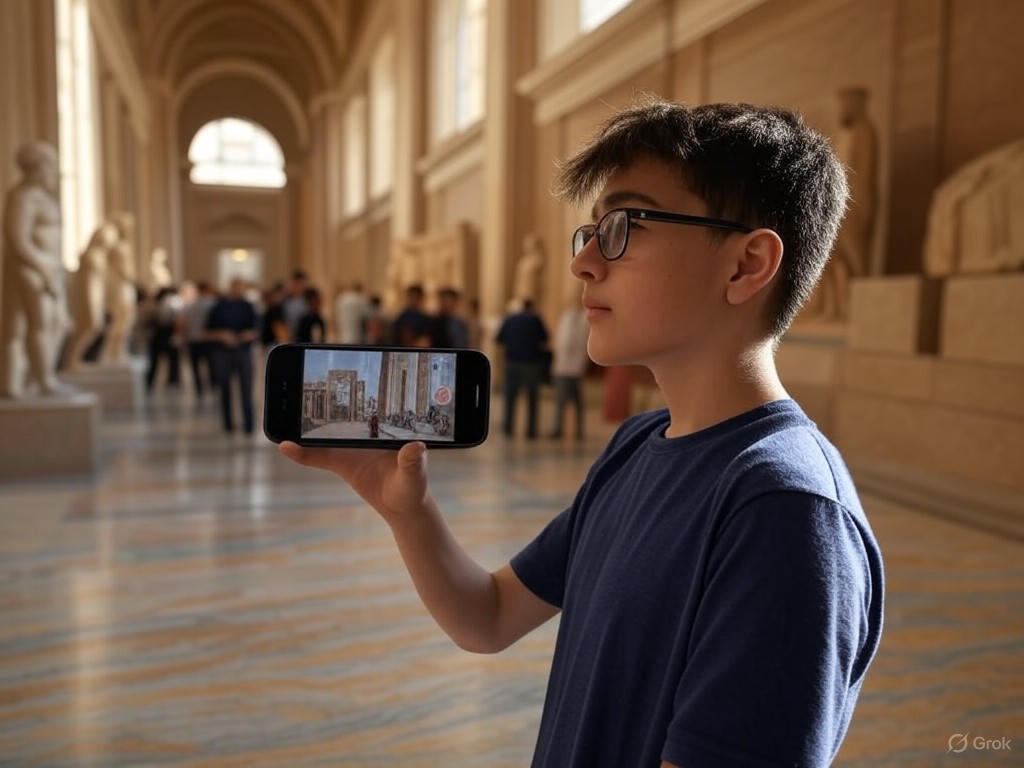Augmented Reality in Museums: Interactive Exhibits
In the grand tradition of storytelling that has captivated generations, from the swashbuckling tales of old to the innovative feats of modern ingenuity, we find ourselves at the threshold of a new era. Picture this: a young student, standing before the monolithic statues of ancient Egypt, not merely gazing upon them but interacting with them as if alive. Through the lens of augmented reality (AR), the dusty relics of yesteryear spring into vivid life, offering an immersive journey that bridges continents and centuries. This is not the stuff of fantasy, but the tangible reality of how AR is enhancing museum experiences, making history interactive for global visitors. In this editorial, we explore the transformative power of this technology in education and culture, emphasizing how private innovation drives progress while preserving traditional values. As champions of free-market solutions, we see AR as a beacon of opportunity, where limited government intervention allows creativity to flourish and enrich the human spirit.
The Dawn of a Digital Renaissance in Museums
Augmented reality, that ingenious blend of digital overlay and real-world interaction, has emerged as a game-changer in the realm of education and culture. Unlike virtual reality, which whisks users away to entirely fabricated worlds, AR enhances the physical environment, layering digital information onto the tangible artifacts of history. Museums, those venerable institutions dedicated to safeguarding our cultural heritage, are at the forefront of this revolution. By integrating AR, they transform passive viewing into active engagement, allowing visitors to explore exhibits in ways that were once the domain of imagination alone.
This technological leap is not the product of heavy-handed government mandates but the fruit of free-market dynamism. Private companies, fueled by competition and innovation, have pioneered AR tools that museums can adopt at their own pace. For instance, institutions like the Smithsonian in Washington, D.C., have partnered with tech firms to create AR experiences that bring historical figures to life, fostering a deeper appreciation for traditional values such as patriotism and intellectual curiosity IEEE Spectrum on AR in Cultural Heritage. Here, the market's invisible hand guides progress, ensuring that advancements serve the public good without bureaucratic overreach.
Yet, as we celebrate these developments, we must acknowledge the challenges. The rapid adoption of AR raises questions about accessibility and the potential for digital divides, but from a center-right perspective, the solution lies in empowering individuals through market-driven affordability rather than expansive government programs. As technology becomes more widespread, its benefits—such as global access to cultural treasures—will naturally extend to more people, upholding the principle that innovation, not intervention, is the true equalizer.

A visitor engages with a holographic recreation of ancient Roman life during an AR tour at the British Museum, blending historical accuracy with interactive storytelling to ignite curiosity in young minds.
Analyzing the Impact: AR as a Tool for Interactive Education
Delving deeper, the analysis reveals how AR is not merely a novelty but a profound enhancer of educational experiences. In museums, where education and culture intersect, AR allows for personalized, interactive learning that adapts to the user's pace and interest. Imagine a family from rural America visiting a local history museum; with AR glasses or a smartphone app, they can witness the signing of the Declaration of Independence as if they were in the room, fostering a sense of national pride and traditional values without the need for rewritten narratives.
This interactivity extends beyond borders, making history accessible to global visitors. Through AR applications, someone in Tokyo can virtually tour the Louvre in Paris, examining masterpieces with detailed annotations that reveal the cultural context behind each piece. Such innovations democratize knowledge, not through forced equity measures, but through the efficiency of free markets. Companies like Google and smaller startups have developed AR platforms that museums can license, creating a ecosystem where competition drives quality and affordability Wall Street Journal on Tech's Role in Museums.
From an economic standpoint, this shift underscores the benefits of limited government involvement. Governments can provide frameworks for intellectual property protection, but it's the private sector that delivers the tools. AR's growth has already contributed to job creation in tech and tourism, with estimates suggesting that interactive experiences could boost museum revenues by up to 20% in the coming years Museum Technology Blog on AR Economics. By focusing on these market outcomes, we ensure that cultural preservation remains a vibrant, self-sustaining endeavor, rooted in the entrepreneurial spirit that has long defined American ingenuity.
Evidence from the Field: Real-World Transformations
The evidence supporting AR's role in museums is as compelling as a well-turned plot in a classic novel. Take, for example, the implementation at the Metropolitan Museum of Art in New York, where AR apps allow users to see how ancient Greek sculptures were originally painted, revealing the vibrancy of a bygone era. Studies indicate that such experiences significantly improve retention and engagement among visitors, with one report showing a 30% increase in visitor satisfaction scores IEEE Xplore on AR Education Metrics.
Globally, institutions are adopting AR to reach wider audiences. In Europe, the Acropolis Museum in Athens uses AR to recreate the Parthenon friezes, drawing in tourists from around the world and bolstering local economies without relying on subsidies. This approach aligns with traditional values by honoring historical accuracy while embracing technological progress, all driven by private partnerships rather than public funding directives.
Consider the data: A recent survey by a leading industry analyst found that 70% of museums plan to integrate AR within the next five years, citing its ability to enhance cultural education without altering core exhibits Forbes Technology Council on AR Trends. These figures underscore the technology's potential to make history interactive and inclusive, not through ideological mandates, but through practical, market-tested applications that respect individual choice and fiscal responsibility.

Children interact with a digital overlay of an Egyptian pharaoh's tomb, demonstrating how AR turns static displays into dynamic educational adventures that celebrate cultural heritage.
Conclusion: A Vision of Progress Through Innovation
As we draw the curtain on this exploration, it is clear that augmented reality stands as a triumphant force in enhancing museum experiences, making history interactive for global visitors. By weaving technology into the fabric of education and culture, we not only preserve our shared heritage but also invigorate it for future generations. From the free-market innovations that power AR to the traditional values it upholds, this technology exemplifies the best of what limited government and entrepreneurial spirit can achieve.
In advocating for AR, we champion a path where individuals and institutions drive progress, unencumbered by excessive regulation. Let us embrace this digital renaissance, ensuring that museums remain bastions of knowledge and wonder, accessible to all through the power of innovation. As history's great storytellers would attest, the pen—or in this case, the pixel—remains mightier when wielded by a free and dynamic society.

